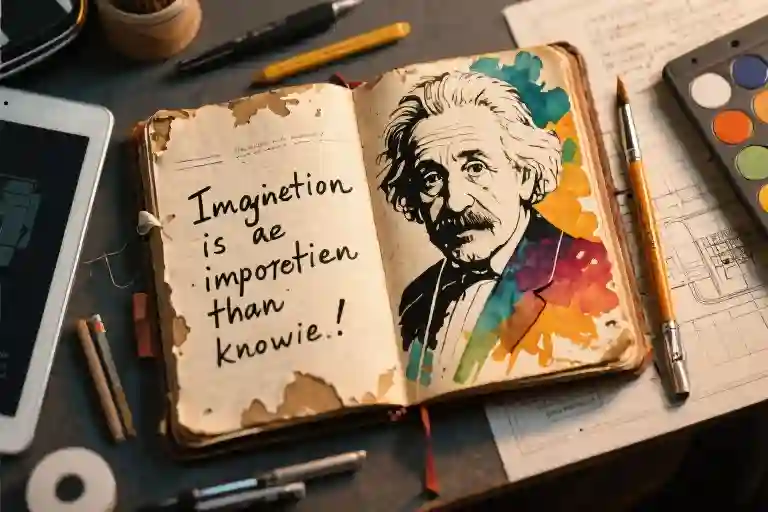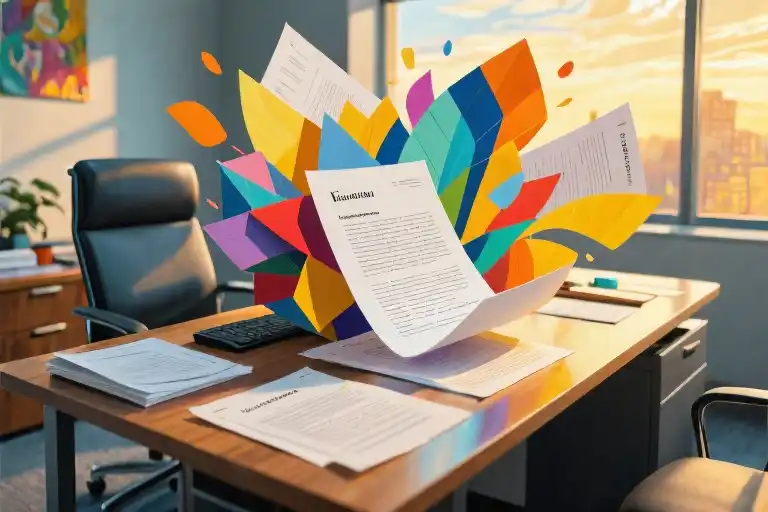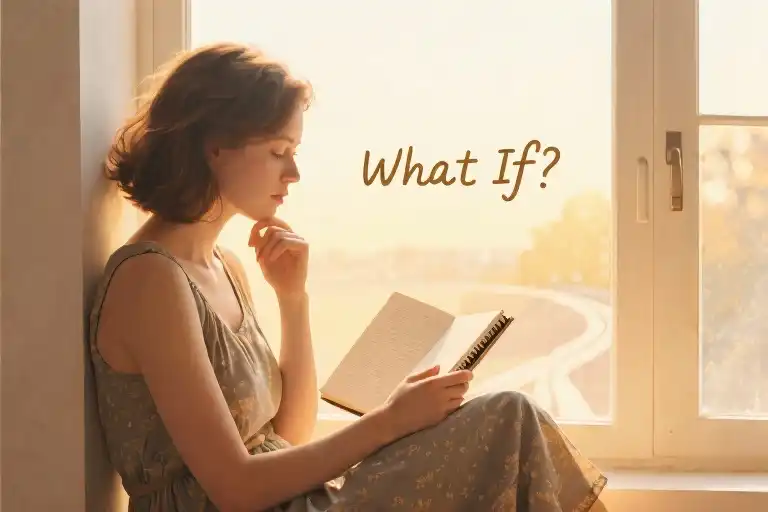The notebook page is yellowed at the edges, the ink slightly faded from decades of preservation. In looping cursive handwriting, a young patent clerk scribbled a thought that would outlive him: “Imagination is more important than knowledge.” That clerk was Albert Einstein, and his creative approach to physics—visualizing riding alongside light beams before doing the math—would reshape our understanding of the universe. Meanwhile, in a Brooklyn studio today, a gifted painter stares at unpaid invoices, wondering if commercial illustration work would betray her artistic integrity. These two moments, separated by a century, are connected by the same unexamined assumption: that creativity belongs exclusively to the arts.
Recent surveys show 68% of visual artists earn less than $30,000 annually, while 94% of writers need day jobs to sustain their craft. The numbers paint a troubling picture of creative potential confined to narrow economic channels. We’ve collectively accepted this reality, nodding along when someone says “starving artist” as if it were a job description rather than a systemic failure. But what if the problem isn’t the market’s inability to value creativity—but our inability to recognize creativity’s full spectrum of applications?
Consider how we compartmentalize human ingenuity. When Einstein imagined the fabric of spacetime bending, we call that genius physics. When Steve Jobs insisted on beautiful circuit board layouts unseen inside devices, we call that business innovation. When a novelist crafts an intricate plot twist, we call that artistic talent. These are all manifestations of the same cognitive muscle, applied to different domains. The artificial boundaries we’ve erected between “creative fields” and “practical fields” may be the very walls keeping so many imaginative minds in financial precarity.
This false dichotomy becomes especially apparent when examining technology revolutions. The personal computing boom wasn’t driven by engineers alone, but by teams blending technical expertise with design thinking—a lesson Apple’s early hires from poetry and calligraphy backgrounds embodied perfectly. Modern startups like Warby Parker didn’t simply sell glasses online; they applied gallery curation principles to e-commerce, transforming a medical device into a fashion statement. These successes didn’t happen despite creativity, but because of its deliberate application beyond traditional artistic contexts.
Yet many creative professionals still operate under what psychologists call the “purity paradox”—the belief that commercial success inherently corrupts artistic vision. This mindset manifests in subtle ways: the writer who won’t consider corporate storytelling gigs, the musician who refuses sync licensing opportunities, the painter who views prints as “selling out.” What begins as protective idealism often hardens into self-sabotage, leaving talent stranded between principles and practicality. The tragic irony? Some of history’s most enduring creative work—from Michelangelo’s Sistine Chapel (a papal commission) to Dickens’ novels (serialized for magazine sales)—flourished precisely because artists engaged with economic realities rather than resisting them.
The central question isn’t whether creativity can survive outside galleries and manuscripts, but why we ever assumed it belonged there exclusively. That patent clerk’s imagination didn’t just give us relativity theory—it demonstrated how creative thinking solves problems across disciplinary lines. Perhaps it’s time we stopped asking “How can artists make money?” and started asking “How many Einstein-level breakthroughs are we missing because creative minds feel compelled to choose between expression and survival?”
Creativity: The Misunderstood Superpower
The human brain doesn’t come with separate compartments labeled ‘artistic creativity’ and ‘scientific problem-solving.’ Modern neuroscience reveals something fascinating – when Einstein daydreamed about riding light beams and when Van Gogh envisioned swirling night skies, their brains lit up in remarkably similar patterns. This default mode network (DMN) activates whenever we engage in creative thinking, whether we’re solving physics equations or composing poetry.
History’s greatest innovators understood this instinctively. Leonardo da Vinci didn’t see boundaries between designing flying machines and painting the Mona Lisa. Elon Musk applies narrative thinking to rocket science, treating engineering challenges like story problems needing elegant solutions. The throughline? They all practiced what cognitive scientists call ‘problem reframing’ – the art of seeing constraints as creative fuel rather than limitations.
Consider how you approach daily challenges. That moment when you rearrange furniture to fit an awkward living space, or devise a new system to manage overflowing email – these are acts of creativity indistinguishable in neurological terms from what happens in an artist’s studio. The difference lies only in application, not essence.
Three questions worth sitting with:
- When did you last solve a non-artistic problem creatively?
- What assumptions about ‘appropriate’ creativity domains might be limiting you?
- How might your unique creative signature apply to unexpected areas?
The most powerful creative breakthroughs often happen at intersections. A graphic designer’s eye for visual hierarchy transforms a cluttered spreadsheet. A poet’s sensitivity to rhythm improves a public health campaign’s messaging. Your creative mind already possesses tools far beyond what any single discipline could contain – the real work lies in giving yourself permission to use them freely.
When Creativity Crosses Boundaries
The hospital whiteboard looked like a Pixar storyboard – doctors sketching patient journeys with colored markers, nurses adding sticky notes with treatment options, family members contributing emotional beats in the margins. This wasn’t animation pre-production, but a revolutionary approach to cancer diagnosis at Massachusetts General Hospital, where medical teams adopted narrative techniques from Pixar to visualize complex cases. The result? 22% faster diagnosis times and patients who finally understood their treatment plans.
Creative problem solving doesn’t discriminate between industries. When J.K. Rowling transformed from a struggling writer to a business strategist, she didn’t abandon her storytelling roots – she weaponized them. Her copyright architecture for Harry Potter became a masterclass in creative asset management, spinning single book concepts into theme parks, merchandise, and theatrical productions while maintaining artistic integrity. The secret wasn’t magical thinking, but applying a writer’s world-building skills to intellectual property law.
Urban planners in Lisbon faced with dangerous traffic intersections took inspiration from an unlikely source: street artists. By treating crosswalks as canvases and using optical illusion techniques typically seen in graffiti, they designed 3D zebra crossings that appeared to float above the road. Drivers instinctively slowed down, reducing accidents by 42% in trial zones. The solution cost less than speed bumps and outlasted traditional paint by years, proving that creative approaches often solve multiple problems simultaneously.
These cases reveal three truths about applied creativity:
- Transferable frameworks – The storyboard technique works equally well for animated films and chemotherapy schedules because both involve sequencing events for maximum clarity and impact.
- Asset thinking – Creative professionals already possess mental models (like world-building or visual deception) that have immense value outside traditional art spaces.
- Measurable outcomes – Real-world creativity isn’t about vague ‘innovation’ but delivering concrete improvements in speed, safety, or revenue.
The most exciting creative work today happens in these borderlands between disciplines. When architects study ballet to design better staircases, or software engineers use poetry principles to simplify user interfaces, they’re not diluting their craft – they’re expanding its reach. Your creative skills are a Swiss Army knife waiting to be deployed in unexpected places; the trick is recognizing that the same mind that composes sonnets can optimize supply chains, that the eye balancing a painting’s composition can also restructure a business proposal for maximum impact.
What makes these cross-pollinations succeed where others fail? The practitioners didn’t just borrow surface-level tricks – they translated core creative principles into new contexts. The doctors didn’t make medical cartoons; they applied Pixar’s narrative clarity to case presentations. The Lisbon planners didn’t commission street art; they harnessed visual perception techniques for public safety. This distinction matters because it means your creative expertise has deeper applications than you might imagine.
Consider how your specific creative training could reformat problems in unrelated fields. A photographer’s understanding of framing could reorganize retail store layouts. A poet’s economy of language might streamline legal documents. The barriers exist mostly in our minds – the world is desperate for these creative translations, if we’re brave enough to make them.
Breaking Through Creative Limitations
Every artist carries an invisible checklist of self-imposed rules. Somewhere between that first childhood crayon drawing and our first professional rejection, we internalize a series of creative constraints that feel as real as gravity. The psychological term is ‘mental models’ – those frameworks that shape how we perceive what’s possible. For creative professionals, these models often become cages.
Take the ‘restricted canvas’ experiment conducted at the Rhode Island School of Design. Researchers gave two groups of students identical art supplies, but told one group their workspace was 30% smaller than it actually was. The constrained group produced technically proficient work, while the other created pieces that judges described as ‘surprisingly innovative.’ The kicker? Both groups had identical physical space. The only difference was their perception of limitation.
This phenomenon manifests in three particularly damaging ways for creative professionals:
The Purity Paradox whispers that commercial success corrupts artistic integrity. We’ve all met that painter who refuses to sell originals (‘They’re my children!’) or the writer who equates royalties with selling out. Yet history’s most enduring artists – from Michelangelo to Maya Angelou – navigated patronage systems while creating timeless work.
The Binary Fallacy insists business and art occupy separate universes. It’s the voice that says ‘I’m terrible with numbers’ right before ignoring invoice deadlines, or the belief that marketing one’s work somehow diminishes its value. Modern creatives like Lin-Manuel Miranda prove otherwise – his Hamilton’s meticulous financial planning (including lottery tickets for students) became as innovative as the lyrics themselves.
The Genius Myth suggests only the chosen few can succeed. We see this when emerging writers compare their first drafts to polished published works, not realizing J.K. Rowling’s Harry Potter manuscript faced twelve rejections. The myth conveniently ignores that most ‘overnight successes’ represent years of disciplined practice.
Where does this leave us? Consider the creative career spectrum:
At one end sits the Purist – creating solely for personal fulfillment, often subsidizing art through unrelated work. At the opposite pole thrives the Hybrid – like graphic novelist Alison Bechdel who turned her diaries into a Tony-winning musical. Between them exists infinite variation, each point valid when consciously chosen rather than defaulted into.
The breakthrough comes when we recognize these constraints as choices, not laws. That gallery owner suggesting smaller canvases might sell better? She’s offering market data, not attacking your vision. That client requesting logo revisions? They’re providing problem parameters that could spark your best work. The creative mind that imagines dragons can certainly envision multiple revenue streams.
Try this self-assessment:
- When last did you decline an opportunity because it felt ‘too commercial’?
- What financial goal would make your creative practice sustainable?
- Which business skill (contracts? pricing?) do you avoid learning?
Your answers map the boundaries of your current creative playground. The good news? Unlike that RISD experiment, you hold the eraser that can redraw those lines.
The Creativity Monetization Playbook
Every artist knows the sinking feeling of staring at a blank invoice, wondering how to translate years of skill into sustainable income. The gap between creative talent and financial stability isn’t about luck—it’s about recognizing that your artistic abilities are transferable problem-solving tools waiting to be deployed in unexpected markets.
From Canvas to Commerce
Consider the case of Elena, a botanical illustrator who struggled to sell original watercolors. Her breakthrough came when she stopped asking “How can I sell more paintings?” and instead asked “Who needs accurate plant illustrations and why?” This simple reframe led her to:
- License her existing artwork to textbook publishers
- Develop specialized workshops for garden centers
- Create digital assets for eco-conscious brands
Her annual revenue increased 400% not by making better art, but by applying creative thinking to business challenges. This is the essence of the skill productization matrix—a framework for systematically converting artistic abilities into multiple income streams.
The Three-Tier Monetization Ladder
Tier 1: Freelance Services (Time for Money)
- Illustration → Corporate storytelling visuals
- Creative writing → Brand voice development
- Photography → Product staging consulting
Tier 2: Intellectual Property (Scalable Assets)
- Turn signature styles into stock media
- Package processes as digital courses
- Develop trademarked techniques
Tier 3: Systematized Business (Ongoing Value)
- Membership communities
- Licensed product lines
- Automated creative tools
Graphic designer Miguel transformed his career using this approach. What began as logo commissions evolved into:
- A font foundry (Tier 2)
- Design thinking workshops for non-profits (Tier 1)
- An AI-assisted branding platform (Tier 3)
His secret? Treating each creative project as a prototype for future monetization.
The Problem Reframing Toolkit
When traditional markets feel saturated, try these four steps to uncover hidden opportunities:
- Deconstruct the Obvious
- List all components of your creative skill
- Example: A portrait photographer’s toolkit includes lighting knowledge, posing expertise, and color grading skills
- Identify Hidden Assumptions
- Challenge “industry standards”
- Why must photography clients be individuals? Could buildings need “portraits”?
- Reverse Key Elements
- What if the deliverable wasn’t the art itself but the creative process?
- Time-lapse videos of artwork creation now command premium prices
- Rebuild the Framework
- Combine unrelated elements
- A ceramicist started selling “corporate therapy workshops” combining pottery with team-building
Your Creative Assets Inventory
Before exploring platforms, conduct an honest assessment:
- Technical Skills: What can you physically/create digitally?
- Process Knowledge: What unique methods do you employ?
- Audience Insights: Who understands your work’s value?
- Supporting Assets: Equipment, studio space, mailing lists
Photographer Jamila discovered her most valuable asset wasn’t her camera gear but her ability to explain complex concepts visually—which led to lucrative medical textbook contracts.
Cross-Industry Collaboration Hubs
Platforms like:
- CreativeMornings (networking)
- Patreon (ongoing support)
- 99designs (contest model)
…are just the beginning. The real gold lies in unexpected partnerships:
- A calligrapher teaching surgeons fine motor skills
- A muralist consulting on office space design
- A poet running corporate storytelling retreats
The checklist for successful跨界collaborations:
- Does this align with my core abilities?
- Can I deliver measurable value?
- Will this open new network pathways?
Remember: Monetizing creativity isn’t about compromising artistic integrity—it’s about expanding your definition of where creativity belongs. Your next paycheck might come from solving a problem you never considered artistic… until you applied your unique way of seeing the world.
Creativity Isn’t What You Make—It’s How You See
The blank canvas stares back at you, but creativity was never about the canvas. That moment when Einstein imagined riding a beam of light—that wasn’t physics yet, just a man playing with possibilities. Most breakthroughs begin this way: not with answers, but with better questions.
For the past week, I’ve been watching my neighbor’s kid build a lemonade stand. She’s six, with paint in her hair and mismatched socks. Her business plan? ‘Lemonade that makes people tell secrets.’ The sign says 50 cents or one good joke. Is this art? Commerce? Neither—it’s pure creative problem-solving in its wildest form.
Your 72-Hour Creativity Challenge
- Day 1: Steal Like a Scientist
Carry a notebook like Marie Curie did. Not for grocery lists, but for capturing every ridiculous idea that would never work. Today, your job is to be wrong beautifully. That doodle of a self-watering plant? The half-baked app idea? Leave rationality at the door. - Day 2: Break Your Own Rules
Take one non-artistic problem you’re facing—maybe a work email you’ve been avoiding, or a closet that won’t organize itself. Solve it using your artist’s toolkit. Storyboard the email. Treat the closet like an installation piece. Notice how constraints become launchpads. - Day 3: Cross the Invisible Line
Message someone doing work you think has nothing to do with yours—a tax consultant, an engineer, a baker. Ask them: What’s one problem you wish someone creative could help solve? Then brainstorm three terrible solutions together. The magic happens in the ‘that’s impossible’ space.
Where To Go From Here
The toolkit we’ve built isn’t complete—it can’t be. Real creativity resists manuals. But if you’re craving more:
- For Your Hands: The Accidental Business Artist – 14 unconventional case studies (including a puppeteer who redesigned hospital waiting rooms)
- For Your Ears: ‘The Messy Middle’ podcast episode where a poet explains how meter thinking helped code better algorithms
- For Your Doubts: The ‘But I’m Not…’ starter pack – proven ways creatives have hacked imposter syndrome in boardrooms, labs, and startup garages
Last week, that six-year-old made $27 in lemonade sales and collected 43 bad jokes. Her secret ingredient? She never once wondered if she was being creative correctly. Neither should you.





